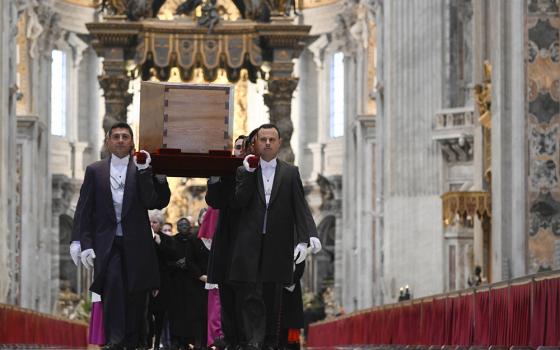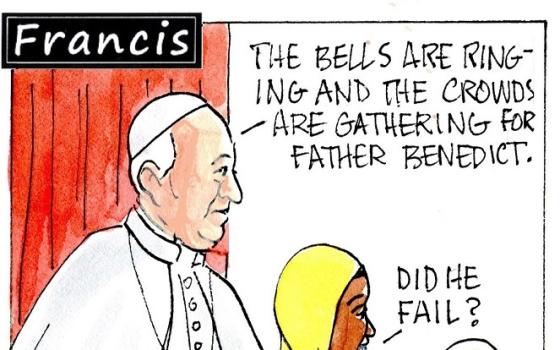The hands of the late Pope Benedict XVI wearing the ring he wore before and after serving as pope and holding a rosary and crucifix are seen Jan. 3, 2022, as his body lies in St. Peter's Basilica at the Vatican. (CNS screen grab/Vatican Media)
"Protocol develops over time, and this has never happened before," the director of the Vatican press office kept repeating in the days after the death of retired Pope Benedict XVI.
"He was not the reigning pope," was one answer he could give.
"Why didn't the bells of St. Peter's Basilica toll his death?" a reporter asked.
They tolled Feb. 28, 2013, marking the end of his pontificate, responded Matteo Bruni, the director.
Why have some nunciatures flown the Vatican flag at half-staff and others haven't?
Bruni attributed that one to "the heart" of nuncios who had a personal relationship with or deep affection for the late pope.
No protocol dictates such a thing since there was no protocol in place for the death of a retired pope, he said.
The last pope to resign was Pope Gregory XII, who stepped down in 1415 and then was named the cardinal-bishop of Frascati, Italy. He died in 1417 and is buried in the Cathedral of San Flaviano in Recanati, about 175 miles northeast of Rome.
In the years before Benedict died, Catholic News Service asked successive directors of the Vatican press office what plans were in place for his eventual funeral rites. The question was not appreciated. And the most complete answer was: "More than for a cardinal, less than for a pope in office."
Pope Francis has said Benedict's resignation makes it easier for a future pope to step down.
Benedict's body was dressed in a red chasuble as it laid first in the chapel of his residence and then in St. Peter's Basilica for the faithful to pay their respects. The red, a liturgical color symbolizing a willingness to shed one's blood for the faith, is the color vestments popes traditionally are buried in. Cardinals usually are buried in a white chasuble.
But unlike the protocol for a pope who died in office, Benedict's body did not have his pallium, a woolen stole worn around the shoulders, or a crozier or the ferula, the pastoral staff. Bruni said he would be buried with his "palliums," like a retired archbishop is.
However, he said he did not know he exact number of stoles or which they were. The late pope received one as archbishop of Munich and Freising, Germany; one as cardinal-bishop of Ostia and dean of the College of Cardinals; and one as pope.
The ferula is never buried with a pope, he added.
The fisherman's ring that he wore as pope had been destroyed a few days after his resignation in 2013. Jesuit Fr. Federico Lombardi, Vatican spokesman at the time, had told reporters that the ring was not smashed or destroyed completely; rather, two deep cuts were made in its face so that it could no longer be used as a seal.
Advertisement
In retirement he reportedly returned to wearing the ring he had worn as a cardinal. Photos of his hands in death showed his ring had a large cross on the face; his fisherman's ring had had an image of St. Peter.
Although many cardinals have said they will come to Rome for the late pope's funeral and all have been invited to concelebrate the Mass, they were not convoked to do so, unlike what would have happened if Benedict had still been in office.
Bruni, director of the Vatican press office, said the only official government delegations present will be those from Italy, where Benedict had served as bishop of Rome, and from Germany, his homeland.
However, several heads of state and other dignitaries announced plans to attend. As of Jan. 3, they included: Spain's Queen Mother Sofia and Félix Bolaños, a government minister; King Philippe of Belgium; Polish President Andrzej Duda; Portuguese President Marcelo Nuno Duarte Rebelo de Sousa; Markus Söder, governor of Bavaria; and Hungarian President Katalin Novak.
And, like popes before him, he will be buried in the grotto of St. Peter's Basilica. The Vatican confirmed his tomb would be in the same small chapel where St. John Paul II's tomb was until 2011 and where St. John XXIII's tomb was until 2001.
The Rite of Reception when his body was brought into St. Peter's Basilica Jan. 2 was more elaborate than the rite for most baptized Christians, but it was simpler than the rite used when St. John Paul II's body was transferred to the basilica for public viewing in 2005.
When the Polish pope died, 12 pallbearers carried his body from the Clementine Hall, down the broad Noble Stairway, through several frescoed rooms on the first floor of the Apostolic Palace, down the Royal Stairway and through the Bronze Doors. They carried the body into the middle of St. Peter's Square, where thousands of people were waiting, then into the basilica through the central doors.
Benedict's body was driven to a side entrance to the basilica, the Door of Prayer, and then carried in by 10 pallbearers as the men of the Sistine Chapel choir sang the litany of saints.
The cardinal camerlengo or chamberlain of the Holy Roman Church presides over the rite of reception of a reigning pope's body; with Benedict, it was the cardinal archpriest of the basilica.
And while cardinals, bishops and priests around the world are expected to offer memorial Masses for the late Benedict -- both before and after his funeral Jan. 5 -- the Vatican had said nothing as of Jan. 3 about a "novendiali," which are nine days of memorial Masses celebrated at the Vatican and at the major basilicas of Rome.
Bruni, the Vatican spokesman, told reporters Jan. 3 that the funeral would be "roughly" the same as a funeral for a pope who died in office.
The night before the funeral, he said, the late pope's body would be placed in a cypress casket. Medals and coins minted during his pontificate will be placed inside as well, along with a metal cylinder containing the "rogito," a brief text describing his pontificate.
After the funeral, the cypress casket will be placed inside a zinc casket and then inside a casket made of oak and buried.




